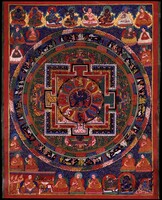Reading a Painting: Lineage

There are four main types of lineage depiction in single composition paintings: [1] Standard Type A, [2] Standard Type B, [3] Two Lineages Type C and [4]. Asymmetrical Type D. These four types can be found in compositions with registers, common to early paintings and with compositions without registers common with the later paintings after the 15th century. From the 18th century to the present a new and additional compositional format was developed that included in a single painting the most significant teaching lineage of a given tradition along with all of the principal meditational deities, special deities and protectors, both general and unique. This compositional format is known as a Field of Accumulation, in brief a Refuge Field painting.
1. In Standard Type A the lineage of teachers begins at the top left and proceeds to the right and then descends to a second or third horizontal register or proceeds to the vertical registers on the left and right side of the composition. Standard Type A is more commonly found in early paintings.
Examples with Registers:
Hevajra Mandala (Dzongpa)
Hevajra Mandala (Kagyu)
Avalokiteshvara
Kagyu Lineage Teachers
Sakya Lineage Teachers
Virupa, Mahasiddha
Kagyu Lineage Teachers
2. In Standard Type B the beginning of the lineage starts with a central figure in the top row of the top register, often Vajradhara or Shakyamuni Buddha and then alternates with the first teacher to the viewer's left and then the right and again to the left - alternating horizontally and then vertically descending down the left and right registers. This Type B is more commonly found with paintings after the 15th century up to the present.
Examples with Registers:
Hevajra Mandala
Krodha Vajrapani
Examples without Registers:
Guru Dragpo
Avalokiteshvara
Kagyu Lineage Teacher
3. In Standard Type C the beginning figure, as in Type B, is in the top central position with one unique lineage of teachers (figures) placed to the left and then descending down the vertical register and a second unique lineage of teachers placed to the right and then descending down the right register. Sometimes, depending on the length of the lineage and number of teachers included, the central figure at the top may be moved slightly to the right of left side to accommodate an uneven number of figures calculated between the two unique lineages [see example].
Examples with Registers:
Vajradhara & Vajradharma
Mahasiddha Lineage Teachers
Examples without Registers:
Gelug Lineage Teachers
Gelug Lineage Teachers
4. In Asymmetrical Type D the top central figure is out of order and directly proceeds in chronological order the main central figure of the composition in the painting. The beginning of the lineage starts either immediately to the viewer's left of the top central figure or in the top left hand corner of the composition. This is generally only found when the central subject is a lineage teacher and not a Buddha, deity, or other such figure.
Examples with Registers:
Kagyu Lineage Teachers
Kagyu Lineage Teachers
Kagyu Lineage Teachers
